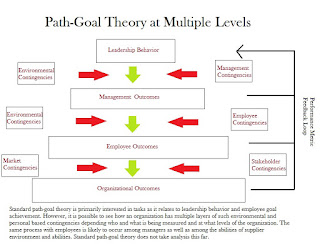Leaders often seek to influence the structures of their
organizations in ways that produce specific meaningful activities.
In many cases, this induced structure can come through additional definition of
which paths/behaviors lead to which type of rewards. Other times it requires an
overhaul of the entire system so that the right paths and pressures can be
created. Professional and skilled labor level employees often interpret such
induced structures differently based upon their current level of role
ambiguity. Robert House’s path-goal theory helps define when and where induced
leadership structure will be beneficial.
Path-Goal Theory is derived from the roots of expectancy
theory which indicates that actions are determined by a person’s assessment of
the possible outcomes and the satisfactions derived from these outcomes. As a
person perceives the possible outcomes and sets upon the obtainment of such an
outcome they weigh and judge the satisfaction of that possible outcome in order
to determine their motivational level and potential behavior.
Expectancy theory is rooted in a subjective experience based
in the persons perception of the possible outcomes and the feelings that person
has toward those outcomes. What is important to one person may not be what is
important to another. Yet despite these differences, cultures place values on
particular outcomes and this can influence what a person sees as the possible
outcome and the personal value of its attainment. For example, a worker from
China and the U.S. may have different goals based in their cultural vantage
points.
In workplace situations, the leader has influence over both
the structure and the job design. When intrinsically motivated behavior results
in extrinsic rewards it can lead to greater motivation. Moving up in an
organization allows one to master more skills and offers opportunities to
expand upon the rewards available. The types of rewards an entry level worker
and a senior administrator may receive are inherently defined by the
organizational structure and the leader’s perception of comparative worth of
their actions.
This level of influence, and potential rewards, are based
within the trust the employee has earned in terms of their abilities, position,
and authority. Those employees who have mastered certain skills over their
lifetimes have higher comparative worth thereby putting them into a position
where they can have more selection over worthwhile rewards. The gaining of
position and its possibilities is an external motivating force that when
matched with intrinsic motivation can be a potent mix.
Robert House’s research hypothesized the following:
- Leadership induced structure improves path instrumentality by reducing ambiguity.
- Leaders influence the subjective values groups assign to outcomes.
- Leadership induced structure will have different impacts on whether or not subordinates see the tasks as positive or negative as well as clear or ambiguous.
House found a relationship between satisfaction, induced
structure and higher level professional jobs. These jobs typically come with
ambiguity and it isn’t always clear what employees need to do in order to
ensure they receive rewards. When the leader implements a level of structure
these ambiguous jobs become more defined and in the end raise the level of
effort on defined paths. It is this collective effort that promotes work unit performance.
In the skilled labor realm, findings were more inconclusive. At
the blue collar level where jobs are already defined and rewards are associated
with particular tasks new structures by leaders were often resented. This may
be one of the reasons why clearly defined union jobs have developed a level of resistance
and immunity to changes proposed by new leaders. To change the nature of tasks
and scope of work could lead to new methods of reward obtainment but would
require adjustments in the predefined and often legally protected workplace
structure.
House’s path-goal work does open up some new possibilities
for organizations with skilled labor that will require more knowledge based
skills to stay competitive. Where jobs become increasingly ambiguous the need
for leadership direction and structure will become more important in order to
maintain momentum on specific goals. It will be this structure and direction
that create paths of least resistance whereby employees will more likely choose
those productive paths to reach their personal goals. Leaders will need to
define what is expected, provide the path, and continue to adjust the skill
requirements of jobs to stay competitive. Where personal expectancies and paths
meet one would hope to find organizational success.
House, R. (1971) A path goal theory of leader effectiveness. Administrative science quarterly, 16
(3).
You may read the full report by signing up for free HERE
